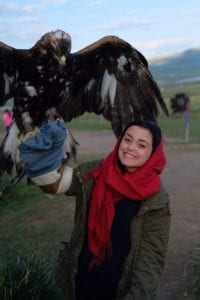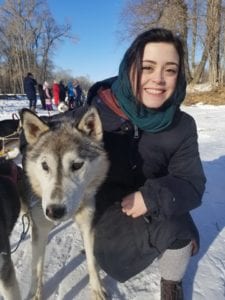
Siera Rayne Hanks, pictured here clutching an eagle in Terelj, Mongolia, returned early to Louisville from her teaching assistantship in that country due to the coronavirus pandemic. (photos provided by Siera Rayne Hanks)
Last August, Siera Rayne Hanks departed Louisville, bound for the adventure
of a lifetime.
The recipient of a Fulbright English teaching assistantship, Hanks, a Jewish Louisvillian and Centre College graduate, expected to spend the next 10 months teaching English at Ider University in the land of Genghis Khan, the Silk Road and cashmere wool.
But things didn’t quite work out that way.
Mongolia shares a 2,880-mile border with China, the original epicenter of the coronavirus.
Even though the Mongolian government closed its border, banned flights from South Korea, stopped the Trans-Siberian Railroad and called off school until March 30 (at least), it wasn’t enough to halt the spread of the virus. Its first confirmed case was reported March 10. Fulbright had already urged its participants to leave the country.
“Mongolia has been quarantined for about two months now,” she said.
After a grueling 20 hours of air travel, with layovers in Istanbul and Chicago, she arrived back in Louisville late on March 12 and voluntarily went into a 14-day period of self-quarantine and “social distancing.”
She is not symptomatic.
“I was super grateful to be able to live in Mongolia,” Hanks said. “I was devastated that I was not able to finish my service, but you can’t control virus; that’s something I don’t have any control over.”
The Fulbright program has placed all its grantees worldwide on “voluntary authorized leave” in response to the pandemic.
An experienced world traveler, Hanks, 23, who lived in the capital city of Ulaanbaatar, was impressed with the way Mongolians handled the coronavirus.
Clubs, bars and restaurants remained open when she left, but with curfews. (“Movie theaters were all the way closed,” she said.)
Supermarkets strictly enforced their customers’ use of hand sanitizer and masks.
Telescreens downtown projected public service announcements.
Businesses received special signs and pamphlets to give away, disseminating useful information and tips.
The government produced a special TV curriculum for kids.
And official celebrations of the Tsagaan Tsar, Mongolia’s lunar new year and the biggest national holiday, were called off.
“As far anything official happening, it has been shut down for many weeks because they responded very early,” Hanks said, “but they didn’t have their first case until March 10, so their prevention methods were effective.”
A bat mitzvah and confirmand from Temple Shalom, Hanks sought out what Jewish life there is in Mongolia, but it wasn’t much.
Centuries ago, Jewish traders trekked the Silk Road from Europe and the Near East to China during the Pax Mongolica, a period of Mongolian-enforced peace and stability during the 13th and 14th centuries.
But while Jews built communities throughout Asia, there isn’t one in Mongolia, “which makes it unique until this day,” Hanks said.
Only a handful of Jews live there. The nearest organized Jewish presence is a Chabad house across the border in the Russian city of Irkutsk.
So Hanks created a little Jewish life of her own. At a holiday party for her Fulbright class, she baked her own challah and procured latkes from a Cuban restaurant in Ulaanbaatar.
The one Jewish presence she found was “Jewish Mongolia,” a new Facebook page, which advertised a Chanukah candle-lighting party at a vegan restaurant.
She wanted to go, so she did.
“I show up and there’s mainly these two older Israelis who are running it and a bunch of people from the Mongolian Baha’i Center,” she recalled, There were Mongolians also who had worked or studied in Israel, “and a Mongolian guy who lived in North Dakota and wanted to network with Jews.”
Vodka, falafel, sufganiyot and an Israeli liqueur were on the menu.
Hanks became friends with one of the Israelis, a 60-something year old man named Jacob, who held Shabbat dinners in his apartment. She said he had converted his living room into minyan space.
A chilling side to Hanks’ stay in Mongolia was the omnipresence of the swastika.
Long before it was adopted by the Nazis, she said, the swastika was a Buddhist symbol representing change, balance and cycles of life. so it is frequently seen throughout east Asia.
“I’ve gotten used to them,” Hanks said. “I’ve seen them in Asia for a while, but in Mongolia, they’re really into the swastika.”
Of course, nationalist groups in the country also use the swastika, masking their use of it with the symbol’s religious meaning.
“They’re kind of cheeky about it,” she said, adding that anti-Semitism is not a serious problem in the country.
Hanks’ Mongolian adventure wasn’t her first in Asia. She has previously traveled in Japan, Myanmar, Thailand, Singapore, South Korea and Bhutan.
She didn’t just teach English at the university. She also ran a human rights club for English speakers on behalf of Amnesty International Mongolia, and she performed outreach for the U.S. embassy, teaching English in western Mongolia near its border with Kazakstan.
She traveled extensively around the country, also known as the Land of the Blue Sky, and despite her shortened stay there, hopes to return.
In fact, she would love to be back in July when Mongolia celebrates Nadaam, its summer festival the athletes compete in the three so-call “manly sports” of horse racing, wrestling and archery. (These days, women have their own competitions, especially in archery.)
“It’s like a huge festival for the whole country,” she said. I’d love to go back and see it.





Nice